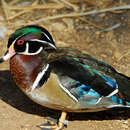en
names in breadcrumbs


The male Wood Duck in breeding plumage is arguably the most colorful duck in North America. Adorned with an iridescent-green head and crest, red bill, rust-colored breast and buff flanks, it is unmistakable anywhere on the continent. However, this is not always the case. Non-breeding males lose their bright colors and become drab brown-gray, resembling female and juvenile Wood Ducks. This is a medium-sized duck species (17-20 inches) which is slightly smaller than the more familiar Mallard. This species breeds across much of North America, especially in the east. In the west, the Wood Duck breeds more locally, but may be encountered on the Pacific coast of California and in the northwest. Many Wood Ducks in the east are permanent residents, but populations breeding in Canada migrate short distances south into the U.S. In the west, Wood Ducks are more migratory, moving into the southern plains and parts of the southwest in winter. This species may be found at all times of the year on wetlands, lakes, and streams. Wood Ducks nest in tree cavities (often old Pileated Woodpecker nest holes), and pairs of this species must breed in wetlands near forests to ensure availability of nest sites. The Wood Duck eats a wide variety of foods, including insects, seeds, fruits, and aquatic plant matter. Wood Ducks are often found floating on the water’s surface, occasionally dabbling (submerging their head and chest while their legs and tail stick out of the water) to find food. These ducks are also capable of taking off directly from the water. They may also be found on land, where they may be observed walking, or in the air, where they may be observed making swift and direct flights through the tree canopy. Wood Ducks are most active during the day.